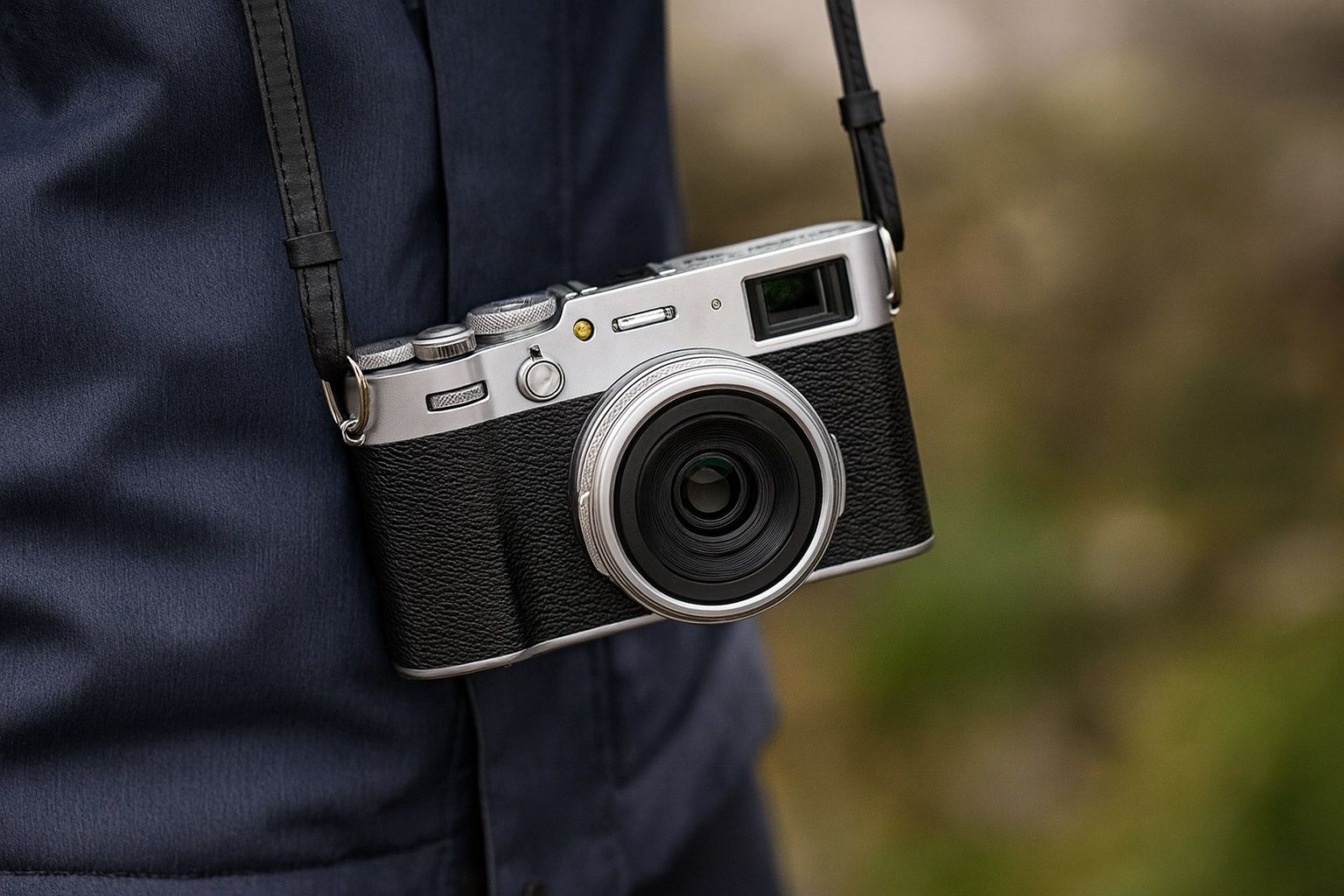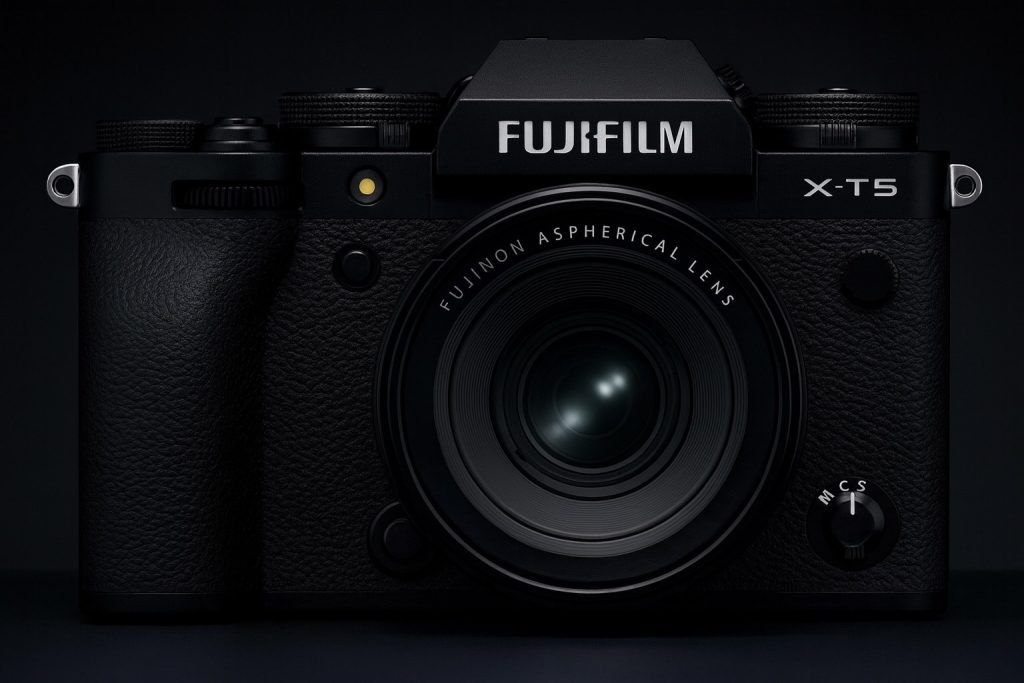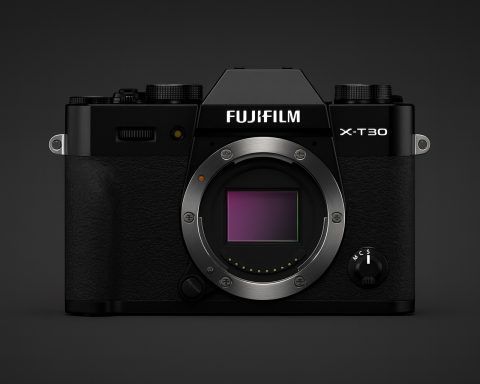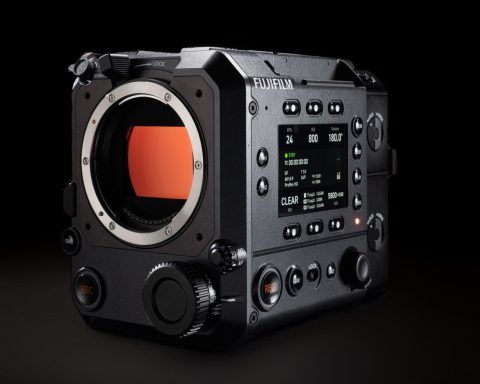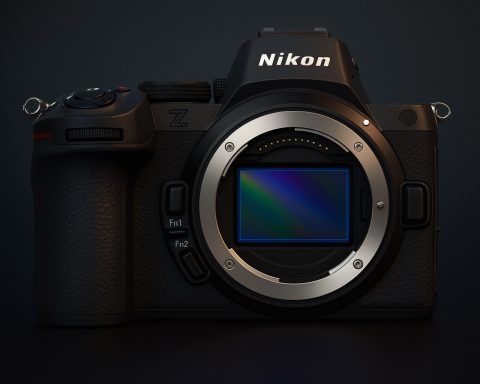- The Fujifilm X100VI, launched in early 2024, uses a 40.2MP X-Trans CMOS 5 HR APS-C sensor and a fixed 23mm f/2 lens.
- The X100VI is the first X100 to add in-body image stabilization, delivering up to 6 stops of shake reduction.
- The X100VI can record 6.2K/30p 10-bit video and 4K/60p, with F-Log2, plus a built-in 4-stop ND filter and digital teleconverters 1.4x and 2x.
- The X100VI uses a hybrid OVF/EVF with a 0.5× optical finder, a 3.69M-dot EVF, and a 1.62M-dot two-way tilting LCD.
- The X100VI weighs about 520g with battery and is priced around $1,799.
- The Fujifilm X-T50, launched mid-2024, shares the 40.2MP X-Trans 5 HR sensor and X-Processor 5 with the X-T5, and adds IBIS up to 7.0 stops.
- The X-T50 offers up to 8 fps mechanical and 20 fps electronic shutter, plus 6.2K/30p and 4K/60p video with F-Log2, and can output 12-bit RAW video via HDMI.
- The X-T50 introduces a Film Simulation (FS) dial on the left side and moves ISO control to a function button instead of a dedicated dial.
- The Fujifilm X-S20, released in 2023, uses a 26.1MP X-Trans CMOS 4 sensor and the X-Processor 5, delivering 4K/60p 10-bit and open-gate 6.2K/30p video with F-Log2, plus ProRes RAW/Blackmagic RAW output via HDMI and compatibility with the FAN-001 cooling fan.
- The X-S20 has the largest battery of the three (NP-W235) for about 750 shots, a deep grip, a fully articulating 3.0-inch touchscreen, built-in 3.5mm mic and headphone jacks, and a body price of $1,299.
Fujifilm X100VI vs X-T50 vs X-S20: In-Depth Comparison and Future Model Insights
Fujifilm’s X-series has something for everyone in 2025 – from a premium fixed-lens compact to feature-packed interchangeable-lens models. In this comprehensive comparison, we’ll pit the Fujifilm X100VI, Fujifilm X-T50, and Fujifilm X-S20 against each other. We’ll break down photo and video performance, core features, sensors, ergonomics, pricing, and target users for each camera. You’ll also find expert insights and review snippets to illuminate how these cameras perform in real-world use. Finally, we’ll look at which model suits various use cases (travel, vlogging, street, hybrid shooting) and peek at upcoming Fujifilm X-series news and rival offerings as of August 2025. Let’s dive in!
Fujifilm X100VI – Retro Charm Meets Modern Tech
The Fujifilm X100VI is the sixth-generation of Fuji’s beloved fixed-lens compact line. Launched in early 2024, it quickly became “the internet’s trendiest camera” thanks to its gorgeous retro styling and hype-worthy upgrades [1]. At its core, the X100VI packs a 40.2-megapixel X-Trans CMOS 5 HR APS-C sensor – a big jump from the 26MP sensor of its predecessor. This high-resolution BSI sensor delivers exceptional detail while maintaining a good signal-to-noise ratio [2] [3]. Expert reviewers note that image quality is superb in both JPEG and RAW, with Fuji’s renowned film simulations providing “better-than-reality color” and creative options galore [4] [5]. The fixed 23mm f/2 lens (35mm full-frame equivalent) carried over from the X100V is tack-sharp across the frame and now fully resolves the new sensor’s detail [6] [7]. This lens, combined with a leaf shutter, enables near-silent shooting and high flash sync speeds – perfect for street photography and candid portraits.
Despite its vintage rangefinder look, the X100VI is thoroughly modern under the skin. Notably, it’s the first X100-series camera to feature in-body image stabilization (IBIS), offering up to 6 stops of shake reduction [8] [9]. Handheld low-light shots and steady video are now much easier with IBIS in this compact. The hybrid viewfinder remains a signature feature – you can switch between an optical viewfinder (OVF) with bright frame lines and an OLED electronic viewfinder (EVF) on the fly [10] [11]. The EVF is high-resolution (approximately 3.69M dots) and the OVF gives that direct optical experience that rangefinder fans love. This unique hybrid system “combines the charm of optical framing with the precision of electronic overlays” [12] [13], truly offering the best of both worlds for composing shots.
For video shooters, the X100VI is surprisingly capable now. It can record up to 6.2K/30p 10-bit video internally, as well as DCI/UHD 4K at up to 60p, and even 1080p up to 240fps for slow-motion [14] [15]. Fujifilm added F-Log2 gamma for expanded dynamic range in video, and reviewers note the footage quality is excellent for a compact camera. That said, the fixed 23mm lens (with no zoom) and lack of a fully articulating screen limit its versatility as a primary video camera. It’s great for travel vlogs or B-roll, but less flexible for complex productions. On the plus side, the X100VI has built-in 4-stop ND filter and now even supports digital teleconverters (1.4x and 2x) to simulate 33mm or 50mm focal lengths with minimal resolution loss [16] [17]. This helps the one-lens limitation by adding a bit of reach when needed.
Ergonomically, the X100VI retains the compact rangefinder-style body that weighs about 520g with battery [18] [19]. It has analog dials for shutter speed, ISO (built into the shutter dial), and an aperture ring on the lens – delivering a “tactile, dial-based design” that users find deeply engaging [20] [21]. A new addition is a flip-out two-way tilting LCD (1.62M-dot) that stays flush to the body when not in use [22] [23]. This tilt screen makes waist-level or overhead shooting easier, though it’s not a full vari-angle display. The camera is solidly built with a machined aluminum top plate, and available in silver or black (plus a limited 90th-anniversary edition) [24] [25]. While not officially weather-sealed out of the box, it can be made weather resistant by using an optional adapter and filter on the lens (similar to the X100V). Battery life is decent but not its strongest suit – expect a few hundred shots per charge from the NP-W126S battery, meaning a spare battery is a good idea for full day outings.
Who is the X100VI for? Enthusiast photographers who crave a beautiful, compact camera that inspires them. According to DPReview’s Gold Award review, this is “a 35mm-equiv camera you can fall in love with” [26] – ideal for street photography, travel, everyday documentary shooting, and anyone who values creative limits. Its fixed lens and rangefinder ethos make you work within one focal length, a constraint many find pushes their creativity. It’s not for those who need flexibility (no zoom or lens swaps) or the fastest action capture. As DPReview quipped, the X100VI is “not so good for anyone looking for flexibility, speed or practicality” [27] [28]. But for many, the “indulgent, tactile image-making experience” it provides is well worth the cost [29] [30]. Priced around $1,799 USD (after a recent price hike from $1,599) [31] [32], it’s a premium device – and indeed demand has far outstripped supply, making it hard to find in stock for much of 2024-2025 [33] [34]. If you want a camera that delivers Leica-like vibes without swapping lenses, the X100VI is tough to beat for street and everyday photography. Just don’t expect it to cover every scenario – it’s a specialized tool that excels within its niche.
Fujifilm X-T50 – Classic Fuji DSLR-Style with Big Upgrades
Stepping into the interchangeable-lens world, the Fujifilm X-T50 is Fuji’s mid-range mirrorless model that debuted in mid-2024. It effectively slots in between the older X-T30 II and the high-end X-T5 [35] [36], inheriting a lot of the flagship’s power in a smaller body. In fact, one of the headlines about the X-T50 is that it shares the same 40.2MP X-Trans 5 HR sensor and X-Processor 5 as the $1,799 X-T5 [37] [38]. This means image quality and autofocus performance are virtually identical to the X-T5 and X-H2 – an impressive feat for a “mid-range” camera [39] [40]. In practical terms, the X-T50 delivers outstanding stills: ultra-sharp resolution, wide dynamic range, and classic Fuji colors. Reviewers gave it high marks for JPEG output and RAW flexibility, noting it produces “great image quality in JPEG and Raw” with the full suite of Fuji film simulations at your disposal [41] [42]. Low-light shooting is solid too – the base ISO is 125 (extendable down to 64) and high ISO up to 51,200 (extended) is there when needed [43] [44]. If ultimate detail is required, the main thing it lacks from the X-T5 is the Pixel-Shift Multi-Shot 160MP mode (that remains exclusive to the flagship) [45].
Crucially, the X-T50 introduces in-body stabilization (IBIS) to the smaller X-T line for the first time, rated at up to 7.0 stops correction [46]. This was a big deal – previously, buyers had to choose between the IBIS-equipped X-S10 series or the non-IBIS X-T30 series. Now the X-T50 gives you both the classic X-T style and IBIS, so you don’t have to compromise on stabilization [47] [48]. Handheld photography in low light and steady video capture both benefit. The camera’s burst shooting is decent, at 8 fps with the mechanical shutter (much slower than the 15 fps of X-T5, one of the few downgrades [49]). However, with electronic shutter it can shoot up to 20 fps (with a 1.29x crop) for fast action, which is on par with the older X-T30 II [50]. Bear in mind that the RAW buffer isn’t very deep at the top burst speeds (around 2 seconds’ worth of images in e-shutter mode) [51], so it’s not an ideal sports camera. Another improvement is the autofocus: it’s the same hybrid PDAF system as X-T5, with deep-learning AI subject detection that recognizes animals, birds, cars, bikes, planes, and trains [52] [53]. You get the latest AF tracking algorithms from Fuji’s X-Processor 5, which means fast and accurate focus for most situations. That said, in practice the X-T50’s continuous AF tracking lags slightly behind some competitors like Sony and Canon. DPReview found its tracking “noticeably a step below peers” in consistency [54] [55]. For single-shot and slower-moving subjects it’s excellent, but for erratic moving subjects or sports, other brands (or Fuji’s stacked-sensor X-H2S) do better.
When it comes to video, the X-T50 is extremely robust for its class. Thanks to that 40MP sensor and fast processor, it can record up to 6.2K 30p video in 10-bit 4:2:2 internally [56] [57]. It effectively matches the X-T5’s video capabilities, offering a 6.2K “open gate” mode (using the full sensor 3:2 area with a slight 1.23x crop) and oversampled 4K modes [58] [59]. You can shoot DCI/UHD 4K at 60p (with no crop for 4K/60) and high-speed 1080p up to 240p for slow motion [60] [61]. Fuji’s F-Log2 profile is included, giving up to 14+ stops dynamic range in video for those who color grade footage [62] [63]. The X-T50 even outputs 12-bit RAW video via HDMI if you use an external recorder (ProRes RAW or Blackmagic RAW) [64] [65]. These are impressive specs, essentially delivering “flagship-level” video on a mid-tier body. In real-world use, reviewers noted the video quality is very detailed, especially using the oversampled modes, though there is some rolling shutter in the 6.2K mode (as expected). Interestingly, tests found the sub-sampled 4K mode (which has lower detail) produced much less rolling shutter and allowed longer recording times without overheating, making it a good default for casual use [66] [67]. The X-T50 is limited to 30 minutes per clip in 4K (and about 60 min at 4K/30) due to heat management [68] [69]. Unlike the video-centric X-H2S or X-S20, it has no option for an external cooling fan. Still, for most users’ needs – short films, YouTube videos, hybrid shooting – the X-T50 is more than capable. It has a microphone input (2.5mm jack) and a USB-C that can be used for headphones via adapter (one area it’s not as convenient as the X-S20, which has a built-in headphone jack).
Design-wise, the X-T50 carries Fujifilm’s classic SLR-style look with top-mounted dials, albeit with a twist. It has dedicated dials for shutter speed and exposure compensation on the right, and notably a new Film Simulation (FS) dial on the left – replacing the drive mode dial present on earlier models [70] [71]. This FS dial is an “innovation” that lets you quickly switch between film simulation modes (with 3 custom preset slots) [72] [73]. It’s great for experimenting with Fuji’s 20 film looks (including the new Reala ACE simulation), though one trade-off is that ISO is now accessed via a function button instead of a dedicated dial (slightly slowing ISO adjustments) [74] [75]. The X-T50 also includes a pop-up flash – a handy bonus for fill light that the X-T5 doesn’t have (the flash is tucked into the EVF hump). The camera’s build is solid and just a bit larger/heavier than the X-T30 II to accommodate the IBIS. It’s not weather-sealed (unlike the higher-end X-T5) [76] [77], and it uses a single UHS-II SD card slot in the bottom compartment. The EVF is a 2.36M-dot OLED with 0.62× magnification – serviceable but “tiny” compared to higher-end finders [78] [79]. Many users coming from X-T3/T4 or other brands might find the viewfinder a bit cramped. The rear LCD is a 3.0-inch, 1.84M-dot screen that tilts up and down (two-axis tilt) and sits flush to the body [80] [81]. It’s not fully articulating, which some vloggers might miss, but it preserves the centered design and is fine for low/high angle shooting in landscape orientation. The grip is modest; overall handling is good for a small camera, though people with large hands or who use long lenses might prefer an add-on grip. One more note: the X-T50 still uses the smaller NP-W126S battery, yielding around 305 shots per charge (390 in eco mode) [82] [83]. This is notably shorter battery life than the X-S20 (which uses a larger battery). Expect to carry spares for long outings.
At launch, the X-T50 was priced at $1,399 USD (body only) [84] [85]. This sits significantly above entry-level models, and as reviews pointed out, “the price… is the biggest downside” of this camera [86] [87]. By comparison, the older X-T30 II launched around $899, so Fuji clearly repositioned the X-Txx line upward. With a kit lens, the cost goes higher: it was offered with a basic XC 15-45mm for $1,499, or with a high-quality XF 16-50mm f/2.8-4.8 OIS WR lens for $1,799 [88] [89]. That new 16-50mm kit zoom is optically excellent and even weather-sealed, but as one reviewer noted, you’re basically being “asked to take a big leap of faith” spending $1,800 for a beginner setup [90] [91]. Indeed, who is the X-T50 for? It’s a bit of a tweener: enthusiast beginners and hobbyists who want a compact camera with room to grow. Fujifilm has positioned it as a great stepping stone for smartphone shooters ready to get serious [92] [93]. The Auto mode lever and approachable controls make it easy to start in full auto and gradually learn manual settings [94] [95]. At the same time, it offers enough performance and lens access that experienced photographers can enjoy it as a travel or everyday camera (one DPReview editor noted he “thoroughly enjoyed” using it even as a seasoned shooter [96] [97]). The X-T50 is good for beginners who want Fuji’s retro style and color science, and hobbyists who value a small system camera [98] [99]. It’s not so good for dedicated action/sports shooters or anyone on a tight budget [100] [101]. In that case, a faster-focusing rival or a cheaper older model might make more sense. Overall, the X-T50 successfully “combines key elements” of the X-T5 and X-T30 II [102] [103]. As Photography Blog concluded, it’s a “logical, if rather calculated” addition to Fuji’s lineup, filling a gap for those who want a lot of the X-T5’s goodness at a lower price point [104] [105]. Just weigh whether its premium over other mid-range options is justified for your needs.
Fujifilm X-S20 – The Tiny Hybrid Powerhouse
The Fujifilm X-S20 is a camera aimed squarely at hybrid content creators – photographers and videographers – packing a remarkable feature set into a compact DSLR-style body. Released in mid-2023 as the successor to the X-S10, the X-S20 might be the most versatile “all-rounder” in Fujifilm’s APS-C stable. It doesn’t have the retro dials of the X-T line; instead it goes with a modern PSAM mode dial (now enlarged and even featuring a dedicated Vlog mode) [106] [107]. Don’t let the conventional design fool you, though – under the hood, the X-S20 brings a lot to the table.
At its heart is a 26.1-megapixel X-Trans CMOS 4 sensor (back-side illuminated). This is the same proven sensor used since the X-T4/X-S10 generation. While it’s lower resolution than the 40MP chips in the X-T50 and X100VI, it’s still capable of gorgeous images with excellent dynamic range and low-light performance [108] [109]. In fact, some reviewers note that the 26MP sensor’s larger photosites give it a slight edge in high ISO noise compared to the denser 40MP sensors – it’s an older sensor, yes, but “can still output gorgeous images with vivid colors” that hold up well in 2025 [110] [111]. The X-S20 is built around the newer X-Processor 5, meaning it inherited improved AF algorithms and, importantly, far better video capabilities than the X-S10. This camera can record 4K/60p 10-bit video internally, and even open-gate 6.2K/30p using the full 3:2 sensor readout [112] [113]. It also offers F-Log2 for up to ~13+ stops of dynamic range in video, and supports output of ProRes RAW/Blackmagic RAW via HDMI [114] [115]. Essentially, the X-S20 turned the X-S line into a mini video workhorse. However, unlike the X-T50, it does not oversample a 6K readout into 4K – it uses line-skipping to achieve 4K/60, which is a minor quality trade-off for the sake of thermals and processing. Even so, its 4K footage is detailed and pleasing, and importantly does not have a crop at 60p (full sensor width) [116] [117]. There is also little crop for 6.2K (just the difference between 16:9 and 3:2 aspect ratio). Because the sensor is not the newer fast-readout type, rolling shutter can be noticeable in certain modes (the Sony a6700’s stacked sensor has an advantage here). But Fuji anticipated heavy video use: the X-S20 is compatible with the FAN-001 external cooling fan (the same one for X-H2/S) that attaches to the back, indicating it’s built with vloggers and long-form shooters in mind [118] [119]. With the fan or in moderate climates, it can record longer clips without overheating – a leg up over some competitors like Sony’s APS-C bodies that often overheat at 4K/60 [120] [121].
Photographically, the X-S20 isn’t far behind the others. It may have fewer megapixels, but it still shoots a respectable 8 fps with mechanical shutter and up to 20 fps with electronic shutter (with a 1.29x crop) similar to its siblings [122] [123]. In fact, DPReview noted it has “good burst shooting speed” overall [124] [125]. The limiting factor is again buffer depth – ~79 JPEGs or ~17 RAWs at 8 fps, and only around 35 RAW frames at 20 fps before slowing [126] [127]. For most hobbyist action (kids, pets, casual sports) this is fine, but not for intense professional sequences. The autofocus system is similar to the X-T4’s: on-sensor phase detection points (2.16M points) with face/eye detect and the newer subject detection modes (animals, vehicles, etc.) thanks to the X-Processor 5. It’s snappy and reliable in many scenarios, but here lies perhaps the X-S20’s only real weakness: “Autofocus trails competitors” like Canon’s Dual Pixel AF II or Sony’s latest AI AF [128] [129]. Continuous tracking on fast subjects is a bit less sticky. Reviewers have advised that if your primary need is tracking fast action or birds in flight, options like the Sony a6700 or Canon R7 will do better [130] [131]. For most users, though, the AF is more than adequate, especially with static or moderately moving subjects. And the X-S20 can automatically apply subject detection in auto mode, which is handy for novice users [132] [133].
One of the X-S20’s standout advantages is usability and battery life. It sports a deeper handgrip than the X-T series, making it comfortable to hold, especially with larger lenses [134] [135]. The control layout is “approachable” – fewer dedicated dials, more customizable buttons, and that fully articulating 3.0-inch touchscreen (1.84M-dot) which is ideal for vlogging and creative angles [136] [137]. Unlike the X-T50’s tilt screen, the X-S20’s vari-angle LCD can face forward for self-recording. The electronic viewfinder is a 2.36M-dot OLED (0.62× magnification), essentially the same spec as X-T50’s – not huge, but serviceable. Importantly, the X-S20 uses Fuji’s larger NP-W235 battery (the same as X-T5/X-H2), allowing approx. 750 shots per charge when using the LCD [138] [139]. This double or more the stamina of the X-T50 or X100VI. Reviewers highlighted the “solid battery life” as a major plus, meaning you can shoot all day or record long clips without quickly draining the battery [140] [141]. The camera’s connectivity and ports also shine: it has both a 3.5mm microphone input and a 3.5mm headphone jack on board [142] [143] – something neither the X-T50 (no native headphone jack) nor X100VI (uses USB-C for audio) offer directly. Add USB-C charging/PD support and micro HDMI, and the X-S20 is well-equipped for modern content creation. The body is not weather-sealed (Fuji’s X-S series remains unsealed), but it is described as well-built and lightweight (~491g with battery). It comes in all-black only, with a clean, understated look.
Price-wise, the X-S20 launched at $1,299 USD (body), undercutting the X-T50 by $100 [144] [145]. Kits were offered at $1,399 with the XC15-45mm or $1,599 with the XF18-55mm f/2.8-4 lens [146] [147]. It’s certainly more expensive than the old X-S10 was, but Fujifilm packed in enough upgrades (new processor, much better video, bigger battery) to justify it. So, who should consider the X-S20? According to DPReview, “if you’re on the hunt for your first ‘real’ camera, the Fujifilm X-S20 is an extremely appealing package.” [148] [149] It is ideal for new content creators, vloggers, and hybrid shooters who want one small camera that does everything well. Fujifilm themselves market it as “a hybrid mirrorless camera for the masses, offering 6K video, 26MP stills, a specific vlog mode and long battery life, all in a small, well-built body.” [150] That description hits the nail on the head. The X-S20 gives you flagship-level performance from 2020 (essentially an X-T4 in many respects) at a mid-range price in 2025 [151] [152]. It lacks the higher resolution sensor and fastest AF of some rivals, but makes up for that by cramming in a ton of features for videos and photos alike [153] [154]. It’s also a great entry into Fuji’s robust X-mount lens ecosystem, which offers far more lens choices than Canon’s APS-C RF lineup and arguably more character than Sony’s offerings [155] [156]. Good for: YouTubers, travel vloggers, family documentarians, and hobbyists who want one camera that can shoot high-quality stills and reliably good video [157] [158]. Not so good for: Pure sports/wildlife specialists (who might need faster AF tracking) [159] [160], or those who prefer the retro control experience (the X-S20’s PASM style is more conventional). In short, the X-S20 is the little Fuji that punches above its weight – a “surprisingly capable APS-C camera” that many reviewers labeled one of their favorites in its class [161] [162].
Key Differences and Comparison Table
Now that we’ve profiled each camera, let’s summarize the key differences and similarities between the Fujifilm X100VI, X-T50, and X-S20:
- Sensor & Image Quality: The X100VI and X-T50 both use Fuji’s latest 40.2MP X-Trans 5 HR sensor, delivering extremely high resolution and detail [163] [164] [165] [166]. The X-S20 uses the older 26.1MP X-Trans 4 sensor – lower resolution but still excellent quality with potentially slightly better high-ISO noise performance per pixel [167] [168]. All three have APS-C sensors with Fuji’s renowned color science and film simulations (20 film sims including new REALA ACE on the latest models). Advantage: X100VI/X-T50 for sheer detail, X-S20 for adequate resolution with possibly cleaner extreme ISO and smaller file sizes.
- Lenses & Mount: The X100VI has a fixed 23mm f/2 lens (built-in, non-interchangeable) which is tack-sharp and now improved for the 40MP sensor [169] [170]. It’s ideal for street and everyday shooting but limiting for other perspectives. The X-T50 and X-S20 both use the Fujifilm X-mount interchangeable lens system, giving access to over 40 native lenses (from ultra-wide to telephoto) [171] [172]. They can leverage Fuji’s fast primes, zooms, third-party lenses, etc., making them far more flexible for different genres (portraits, sports, macro, etc.). Advantage: X-T50/X-S20 for versatility; X100VI is a one-lens specialist (though it has optional wide/tele converters and digital teleconverters to extend its reach modestly).
- Autofocus: All three benefit from Fuji’s latest AF algorithms via the X-Processor 5, including subject detection (animals, birds, vehicles, etc.) and face/eye detect [173] [174] [175] [176]. In single-shot AF, performance is fast and accurate on all. Continuous AF tracking is where differences emerge. The X-T50 and X-S20 both struggle a bit to keep up with the best from Sony/Canon for fast-moving subjects – reviews note they are a step behind in tracking consistency [177] [178] [179] [180]. The X100VI, with essentially the same AF system (and a newer sensor), should perform similarly; however, its use cases (street, travel) are less about sports action anyway. Advantage: Roughly tied – all are good, but none are class-leading in AF-C. Good enough for most needs; serious action shooters might seek a different model (like Fuji X-H2S or rivals).
- Stabilization: The X100VI has 5-axis IBIS up to 6.0 stops – a first for X100 series [181] [182]. The X-T50 has 5-axis IBIS up to 7.0 stops (the most effective here) [183]. The X-S20 also has 5-axis IBIS rated around 7 stops (CIPA) [184] [185]. In practice, all three allow handheld shooting at much slower shutter speeds and steadier video. The X-T50 and X-S20’s IBIS systems are a tad more advanced in spec. Advantage: X-T50/X-S20 by a slight margin in rating, but practically all have effective stabilization. (Notably, older X100 models lacked IBIS entirely, so the X100VI’s IBIS is a huge upgrade for fans of that line.)
- Viewfinder & LCD: The X100VI features the unique hybrid OVF/EVF with a 0.5× mag optical finder and a 3.69M-dot EVF – giving a big, bright experience and the flexibility to switch modes [186] [187]. The X-T50 and X-S20 both have 2.36M-dot OLED EVFs, 0.62× magnification [188] [189] [190] [191]. These are smaller/less detailed but usable. For LCDs, X-T50 and X100VI use tilting screens (X100VI’s 2-way tilt, X-T50’s 2-way tilt), whereas X-S20 has a fully articulating vari-angle screen that flips out to the side and front [192] [193]. Advantage: X100VI for optical finder fans and a higher-res EVF; X-S20 for flexible flip-out screen (great for video and selfies); X-T50 is middle-ground (tilt-only, small EVF).
- Video Features: All three can shoot 6.2K video around 30p and 4K up to 60p with 10-bit color and F-Log profiles [194] [195] [196] [197] [198] [199]. The X-T50 and X100VI share very similar video specs (6.2K 30p 4:2:2 internal, 4K/60, 1080/240 slow-mo, etc.) [200] [201] [202] [203]. The X-S20’s headline is 4K/60 4:2:2 and open-gate 6.2K with the option of using an external fan for longer recordings [204] [205]. One difference: X-T50 offers oversampled 4K HQ modes (from 6.2K) for maximum detail [206] [207], whereas X-S20’s 4K is line-skipped (slightly less crisp, but still good). The X100VI, due to its compact size, might thermal throttle sooner; the X-T50 is limited to ~30 min at 4K/60 [208] [209]; the X-S20 with a big battery and optional fan is best suited for long takes. Also, X-S20 and X-T50 can output RAW video via HDMI, while X100VI likely cannot (it’s more consumer-oriented). Advantage: X-S20 for serious video shooters (articulating screen, headphone jack, longest battery, cooling option). X-T50 is very close in spec but less ergonomic for video (no headphone jack, shorter battery). X100VI is surprisingly strong in video for a fixed-lens compact, but not the first choice if video is a primary concern.
- Physical & Battery: The X100VI is the most compact (fixed lens, no mount) and weighs ~520g [210] [211]. The X-T50 is slightly larger with a moderate grip, 557g with battery. The X-S20 has the deepest grip and weighs ~491g [212] [213], but that weight difference is partly the bigger battery. Battery life: X100VI ~350 shots, X-T50 ~305 shots (per CIPA) [214] [215], X-S20 ~750 shots (thanks to NP-W235) [216] [217]. None are battery monsters like some full-frame, but the X-S20 clearly lasts much longer per charge. None of the three is fully weather-sealed. Only the X-T50’s optional kit lens (16-50mm WR) was sealed, but the body itself is not [218] [219].
Below is a quick spec comparison table for reference:
| Camera Model | Fujifilm X100VI (2024) | Fujifilm X-T50 (2024) | Fujifilm X-S20 (2023) |
|---|---|---|---|
| Sensor | 40.2MP X-Trans CMOS 5 HR (APS-C, BSI) [220] [221] | 40.2MP X-Trans CMOS 5 HR (APS-C, BSI) [222] [223] | 26.1MP X-Trans CMOS 4 (APS-C, BSI) [224] [225] |
| Image Processor | X-Processor 5 | X-Processor 5 | X-Processor 5 |
| Lens / Mount | Fixed 23mm f/2 lens (35mm equiv.) [226] [227] (Leaf shutter, 4-stop ND filter) | Fujifilm X-mount (interchangeable lenses) | Fujifilm X-mount (interchangeable lenses) |
| Stabilization | Yes – 5-axis IBIS (up to 6.0 stops) [228] [229] | Yes – 5-axis IBIS (up to 7.0 stops) [230] | Yes – 5-axis IBIS (up to ~7.0 stops) [231] [232] |
| Viewfinder | Hybrid OVF/EVF (OVF + 3.69M-dot OLED EVF) [233] [234] | 2.36M-dot OLED EVF (0.62× magnification) [235] [236] | 2.36M-dot OLED EVF (0.62× magnification) [237] [238] |
| Rear LCD | 3.0″ 1.62M-dot tilting TFT [239] [240] | 3.0″ 1.84M-dot 2-way tilting TFT [241] [242] | 3.0″ 1.84M-dot fully articulating TFT [243] [244] |
| Continuous Shoot | Up to ~11 fps mech. (approx. 20 fps elec. with crop) [245] | 8 fps mech., 20 fps elec. (1.29× crop) [246] | 8 fps mech., 20 fps elec. (1.29× crop) [247] |
| Autofocus | Hybrid PDAF + CDAF, AI subject detect (faces/eyes, animals, etc.) [248] [249] | Hybrid PDAF + CDAF, AI subject detect (same as X-T5) [250] [251] | Hybrid PDAF + CDAF, AI subject detect (similar to X-T4) [252] [253] |
| Video Max Res | 6.2K (3:2) at 30p 10-bit; 4K DCI/UHD up to 60p 10-bit [254] [255] | 6.2K (3:2) at 30p 10-bit; 4K DCI/UHD up to 60p 10-bit [256] [257] | 6.2K (3:2 open-gate) at 30p 10-bit; 4K DCI/UHD up to 60p 10-bit [258] [259] |
| High-Speed Video | 1080p up to 240 fps [260] [261] | 1080p up to 240 fps [262] [263] | 1080p up to 240 fps (with slight quality loss) |
| Log Profile | F-Log2, HLG (10-bit internal) [264] [265] | F-Log2, HLG (10-bit internal) [266] [267] | F-Log & F-Log2 (10-bit internal) [268] [269] |
| External Video | Micro HDMI (10-bit out; no RAW output) | Micro HDMI (supports 12-bit RAW to Atomos/BMD) [270] [271] | Micro HDMI (supports 12-bit RAW to Atomos/BMD) [272] [273] |
| LCD/EVF for Vlog | Tilt screen (not front-facing); no built-in headphone jack | Tilt screen (not front-facing); no headphone jack on body | Fully articulating screen (front-facing); has headphone jack [274] [275] |
| Built-in Flash | No (but leaf shutter syncs flash up to ~1/2000s) | Yes – pop-up flash built-in (GN ~5) [276] [277] | No built-in flash |
| Storage Slot | 1× SD UHS-I card slot [278] [279] | 1× SD UHS-II card (in battery compartment) [280] [281] | 1× SD UHS-II card (in battery compartment) |
| Battery / Life | NP-W126S (approx. ~350 shots) | NP-W126S (CIPA ~305 shots, 390 in eco) [282] [283] | NP-W235 (CIPA ~750 shots LCD) [284] [285] |
| Dimensions (WxHxD) | ~128 × 75 × 55 mm [286] [287] | ~123 × 85 × 54 mm (smaller than X-T5) [288] [289] | ~127 × 85 × 65 mm (deeper grip for battery) |
| Weight | 520 g (with battery) [290] [291] | 557 g (with battery) | 491 g (with battery) [292] [293] |
| List Price (USD) | $1,799 (fixed lens camera) [294] [295] | $1,399 body-only [296] [297]; $1,799 w/16-50mm kit [298] [299] | $1,299 body-only [300] [301]; $1,599 w/18-55mm kit [302] [303] |
Table: Quick comparison of Fujifilm X100VI, X-T50, and X-S20 key specifications.
Looking at the table and features: The X100VI stands apart as a premium fixed-lens compact – it’s all about that hybrid viewfinder experience and street-ready package with top-notch imaging, but no lens flexibility. The X-T50 and X-S20 share a lot of capabilities (same processor, both stabilized, both can do 6K video), but differ in design philosophy. The X-T50 is for those who love Fuji’s classic controls and don’t mind a smaller battery or a slightly higher price for the retro styling. The X-S20 is for those who value practical features like a selfie screen, big battery, and easier video operation, even if it means a more “modern” interface.
Which Camera for Which Use Case?
Each of these cameras excels in different scenarios. Here’s a breakdown of which model might be “best” for various uses:
- Street Photography & Everyday Carry: The X100VI is tailor-made for street shooters. Its silent leaf shutter, built-in ND filter (for shooting wide open in daylight), and unobtrusive rangefinder style make it ideal for candids and travel journals. As one photographer put it, the X100 series has been their “first and best photography teacher” due to its simplicity and fixed lens discipline [304] [305]. The X-T50 and X-S20 can certainly do street as well – put a small prime (e.g. 27mm or 35mm) on them and they’re quite stealthy. However, the X100VI’s all-in-one nature (no lens swapping needed) and iconic design arguably inspire a more carefree shooting style. If you want to “fall in love” with a camera for daily life documenting, the X100VI is the one that reviewers say “you can fall in love with” [306] [307]. Recommendation:X100VI for pure street photographers and everyday snapshots with style; X-T50 or X-S20 if you anticipate needing alternate focal lengths (then X-T50 with a pancake lens gives a similar feel, or X-S20 for a slightly larger but still portable kit).
- Travel Photography: This one is a bit of a toss-up. The X100VI is great for travel if you’re comfortable with a single 35mm-equivalent lens. It’s compact, sturdy, and you’ll never have sensor dust issues (since you’re not changing lenses on the go). Plus, the hybrid OVF lets you see outside the frame – great for street scenes or anticipating subjects entering your shot. On the other hand, X-T50 and X-S20 let you carry a couple of lenses to cover wide vistas and zoomed shots. For example, an X-S20 with an 18-55mm and a 70-300mm lens would cover a huge range and still weigh relatively little – beneficial for landscapes, architecture, and distant subjects. The X-S20’s big battery is a plus when traveling without frequent charging opportunities. If video vlogging your journey is a priority, the X-S20’s front-facing screen and better mic/headphone setup make it the clear winner for travel vlogs. Recommendation: If you’re a one-camera, one-lens purist or traveling light through cities, X100VI offers a zen-like simplicity (and superb quality) for travel storytelling. If you want flexibility for landscapes, telephoto wildlife or family shots on vacation, X-S20 is arguably the best travel all-rounder (long battery, IBIS, and any lens you need). The X-T50 sits in between – great image quality for travel scenes, and with a compact zoom like the 18-55mm it’s a fantastic travel combo, albeit with shorter battery life.
- Vlogging & Video Content: The X-S20 was designed with vloggers in mind. It has the fully articulating screen (so you can see yourself while recording), a dedicated Vlog mode on the dial (which automatically optimizes settings for face exposure, etc.), and both mic and headphone jacks built-in [308] [309]. It also supports the tripod grip with Bluetooth (TG-BT1) and even the cooling fan for longer takes. In contrast, the X-T50’s screen only tilts (making self-filming tricky unless you use an external monitor or tilt it and stand in a weird position), and you’d need a USB-C dongle for headphones. The X100VI, while capable of great video, is not ideal for vlogging: its screen can’t face forward, its fixed 23mm lens might be a bit tight for handheld selfie video (35mm equiv – some prefer a wider 24mm equiv for vlogs), and there’s limited means to mount accessories (though you can use the hot shoe for a mic). Also, the X100VI’s internal mic is okay but not stellar – you’d want an external mic via the 2.5mm jack or an adapter. Recommendation:X-S20 wins for vlogging/hybrid video creators. It’s the most convenient and reliable for video use cases. The X-T50 can serve for video projects or B-roll if you work around its limitations (it certainly has the quality), and the X100VI is fine for casual clips or artistic video, but it wouldn’t be a vlogger’s first pick.
- Portrait & Event Photography: For portraits (especially with shallow depth of field), an interchangeable lens camera is preferable. The X-T50 or X-S20 paired with a fast prime (like the XF 50mm f/1.0 or 56mm f/1.2, or even the 90mm f/2) will produce beautiful subject isolation and professional results. The X100VI, with its 23mm f/2, can certainly do environmental portraits (it excels at full-body or contextual portraits with some background), but it’s not the classic portrait focal length nor as able to blur backgrounds heavily. At events, having lens flexibility and dual card slots is often desired – note that none of these three have dual card slots (that’s reserved for higher-end bodies like X-T5). Still, between them, the X-T50 might be chosen by an enthusiast for events due to its higher resolution (cropping flexibility) and flash sync port (it can use an external flash via hot shoe, as can the others). The X-S20 could handle events too; its lower MP is fine and it won’t fill memory cards as fast. The main difference is viewfinder vs handling preference while shooting lots of photos in a dynamic environment. Recommendation:X-T50 if you want maximum image quality for portraits and the traditional controls; X-S20 if you prioritize battery life during events or plan to mix video coverage (for example, recording clips during an event along with photos). X100VI would not be the first choice for dedicated portrait sessions or covering an event, due to its single wide lens – though it could be a lovely second camera for candid shots at events.
- Sports, Action and Wildlife: Candidly, none of these are specialized sports/wildlife cameras. Fuji’s own X-H2S (with a stacked sensor and faster bursts) or competitors like the Canon R7 or Sony a6700 would be more suited for intensive action shooting. That said, between these three, you’d lean on the interchangeable lens models. The X-T50 and X-S20 can both shoot 20 fps with electronic shutter (with 1.25x crop) and can use telephoto lenses like the XF 70-300mm or 100-400mm. The X-T50’s 40MP sensor yields a lot of detail for wildlife, but its buffer will choke quickly on RAW bursts and its AF tracking is only middling for fast subjects [310] [311]. The X-S20’s tracking is similarly middling, but one could argue its slightly lower resolution sensor might handle noise a tad better if you’re shooting in the early morning/late evening light at higher ISOs (common in wildlife). Also the X-S20’s deeper grip could balance longer lenses better, and its bigger battery means you won’t run out of juice halfway through a soccer game or hike. The X100VI is not built for sports – its 35mm equiv lens is too wide for most sports/wildlife, and though it has fast burst, you can’t zoom to capture distant action (unless you’re right on the sidelines, and even then, limited). Recommendation: Neither the X-T50 nor X-S20 is ideal for critical sports or wildlife use, but if you’re a hobbyist doing occasional action, consider the X-S20 for its battery and handling with tele lenses. If resolution is paramount (for example, cropping small birds in frame) and you can live with shorter bursts, the X-T50 could be considered – just manage your expectations on keeper rate. For serious action, one would likely look beyond these three.
- Landscape & Architecture: Landscapers often appreciate high resolution and dynamic range. The X-T50’s 40MP sensor provides extra detail to capture sweeping vistas or intricate architectural shots [312] [313]. It also has the advantage of those classic controls which many landscape photographers enjoy using deliberately on a tripod (dialing in shutter speed, etc.). The downside is battery life if you’re doing time-lapses or long hiking trips – you’ll need spares. The X-S20’s 26MP is still plenty for large prints (you can make gorgeous prints several feet wide with 26MP), and it has that nice battery stamina for multi-day treks. Also, if you shoot video of landscapes (maybe you hike and take videos of the scenery), the X-S20 might be more appealing. Both can use ultra-wide lenses; Fuji has a 8-16mm f/2.8, 10-24mm f/4, etc. The X100VI has a fixed 23mm (which is a 35mm equivalent – moderately wide but not ultra-wide). That limits it for sweeping landscapes or tight interiors architecture. It can take spectacular travel landscapes, but you might find yourself wishing for a wider or longer lens at times. Recommendation:X-T50 for maximum photo detail in landscapes/architecture (especially if you mostly do stills and can carry extra batteries). X-S20 if you want a lighter kit, maybe pair it with the XF 10-24mm for wide shots, and value the battery life. Also the X-S20’s IBIS can help for handheld low-light cityscape shots (though X-T50 also has IBIS, the difference is minor there). X100VI would not be the first pick for dedicated landscape photographers, but it can certainly capture beautiful scenes within its focal length – just no composition flexibility beyond “foot zoom.”
- Beginner Learning and General Use: If someone is a beginner who wants to learn photography fundamentals, all three could work but provide different experiences. The X-T50 might actually be a fun learning tool because it has that new Auto mode lever for when you need a quick bailout to full auto [314] [315], and the film simulation dial to experiment with in-camera looks [316] [317]. It still encourages understanding shutter/aperture via its dials. A beginner with a bigger budget who is enthusiastic about the craft would appreciate the X-T50’s balance of ease and depth. The X-S20, with its simpler controls, might be less intimidating initially – you can use it like a typical modern camera (mode dial on Auto or Scene modes, etc.). It’s described as “approachable” for beginners [318] [319]. It also has that Vlog mode and better auto scene detection, which could help a novice get good results out of the gate. The X100VI is a bit of an outlier here – a beginner could enjoy it if they want a premium point-and-shoot experience and are okay with just one focal length. It will certainly force them to focus on composition and “seeing” since they can’t zoom – which can actually accelerate learning. However, its cost is high for a beginner, and its appeal is more for someone who already knows they love photography and want that specific experience. Recommendation:X-S20 for most newbies who want a gentle learning curve and a camera that can do a bit of everything as they discover their style. X-T50 for beginners who are very interested in the photographic process and perhaps coming from film or rangefinder curiosity – it provides that tactile learning experience (with the safety net of Auto and excellent JPEGs). X100VI is not aimed at typical beginners, but could be a dream camera for a student of photography who wants to learn through a fixed lens limitation (though arguably an X100V used, or even a cheaper X-E4 plus a prime lens, would achieve similar at a lower entry cost).
In summary, there isn’t a single “best” camera here – it truly depends on your priorities. Each model shines for a different user profile:
- X100VI – Best for the purist/enthusiast who wants a compact, beautiful camera for everyday moments, travel, and street scenes, and doesn’t need interchangeable lenses. It’s about the joy of photography in a simplified form.
- X-T50 – Best for the serious hobbyist or budding photographer who loves Fuji’s classic styling and wants high-end performance (40MP, 6K video, IBIS) in a smaller package. Great for those who primarily shoot photos (and some video) and value image quality and lens flexibility in a retro form.
- X-S20 – Best for the hybrid content creator or pragmatic shooter who needs one camera to handle everything – from high-quality stills to vlogs and YouTube videos. It’s the choice for travel vloggers, family documenters, and anyone who wants maximum versatility and endurance in a small camera.
Future Outlook: Upcoming Fujifilm X-Series and Competitors (as of Aug 2025)
The camera world doesn’t stand still – and neither does Fujifilm. As of August 2025, there are some exciting developments and rumors in the Fujifilm X-series lineup, as well as noteworthy moves from competitors:
- Fujifilm X-E5: Rangefinder fans rejoice – Fuji officially announced the X-E5 in June 2025, with availability from August 2025 [320] [321]. The X-E5 is essentially an X-T50 in a flat rangefinder-style body. It packs the 40.2MP sensor, X-Processor 5, and even IBIS into the compact X-E series design [322] [323]. Notably, it also gets a Film Simulation dial like the X-T50, and the EVF is flush-mounted on the left side. This is a big upgrade from the X-E4 (which was 26MP and no IBIS). The X-E5 aims to blend that classic rangefinder look with modern performance – it’s basically Fuji’s answer to those wanting an X100VI with interchangeable lenses. However, it comes at a higher price: around $1,699 USD body-only [324] [325], which raised some eyebrows as it’s close to X-T5 territory. Still, it fills a gap for a high-end rangefinder-style APS-C body. If you love the form factor of the X100 but want to use different lenses, the X-E5 is one to watch. (It even launched alongside a tiny XF 23mm f/2.8 pancake lens to keep the setup slim [326] [327].) Early info confirms X-E5 has the 40MP sensor, IBIS, 6.2K video, etc., just like its X-T50 sibling [328] [329]. Essentially Fuji now has two 40MP mid-tier bodies: SLR style (X-T50) and rangefinder style (X-E5).
- Fujifilm “Half Frame” Camera: Rumors suggest Fuji might be working on a more affordable entry-level camera, intriguingly referred to as a “half frame” camera [330] [331]. In FujiRumors’ 2025 roadmap, a “Fujifilm half frame camera” is listed as rumored [332] [333]. The term “half frame” is a bit confusing – it could imply an even smaller sensor format (unlikely for X-series, which has always been APS-C), or it might be a codename. Some speculate it could be a revival of the old X-A series (Fuji’s former entry-level line) or something entirely new. Details are scarce, but if it comes, expect a lower-cost model aimed at casual users – possibly without an EVF, just a screen (like Fuji’s older X-M1 or X-A models). It’s an area Fuji hasn’t addressed since discontinuing the X-A7. Keep an eye out for announcements; if it materializes, it would sit below the X-S20 in price.
- No X-Pro4… Yet: Rangefinder aficionados have been clamoring for a true successor to the flagship X-Pro3. However, reliable sources indicate that no X-Pro4 will arrive in 2025 [334] [335]. FujiRumors explicitly stated “there won’t be any Fujifilm X-Pro4 or X-Pro5… in 2025” [336] [337]. Fuji appears to be focusing on other models for now. Some insiders suggest maybe 2026 for an X-Pro4 at earliest, possibly skipping a number (hence mention of X-Pro5). So, for 2025, X-Pro3 remains the latest in that line (though it was discontinued, making it hard to find new). This news might disappoint X-Pro series fans, but the X-E5 filling in as a mini X-Pro is perhaps Fuji’s interim solution.
- Other Fuji X-Series Rumors: There’s chatter but nothing concrete about an X-T6 or X-H3S, etc. According to FujiRumors, any rumors about X-T6 or X-H3 series in 2025 are unfounded – those are not expected this year [338] [339]. The X-H2 and X-H2S from 2022 are still top of the line and will likely have a longer lifecycle. Fuji did release firmware updates bringing new AF features to models like X-T5, X-T50, X-S20, X100VI, etc., showing they’re improving existing cameras via firmware in lieu of rushing new hardware [340]. On the lens front, a new XF 23mm f/2.8 pancake lens launched with the X-E5 (a compact option for street shooters) [341] [342]. Also rumored is a potential XF 33mm f/1.0 or other fast primes, but nothing confirmed at this time. Fujifilm also continues to develop its GFX medium format line (e.g., the GFX100RF announced in 2025, a fixed-lens medium format concept [343] [344]), though that’s a different segment.
- Competitors – APS-C Mirrorless: The competition in the enthusiast APS-C space in 2025 includes Sony’s a6700, Canon’s EOS R7/R10, and Nikon’s Z50/Zfc (and new Z50 II). Sony a6700 (released mid-2023) is a 26MP APS-C mirrorless that many compare directly to Fuji’s offerings. It has a stacked sensor for fast readout, excellent Sony AF, 4K/120 video (cropped) and AI-based subject recognition. DPReview noted the a6700 beat the X-T50 in autofocus and offers uncropped 4K/60, but found Fuji produced nicer JPEG colors and a more fun shooting experience [345] [346]. The a6700 did suffer from some overheating in 4K/60 and has a more utilitarian design [347] [348]. Still, for action or purely spec-driven users, the Sony is a formidable rival (price ~$1,400). Canon EOS R7 (32.5MP, launched 2022) is another strong competitor – it offers up to 15 fps mechanical, excellent Dual Pixel AF, and 4K/60 (with a slight crop). It was even mentioned by reviewers comparing to X-T50: image quality on R7 is similar, AF is more advanced, burst is faster, but Canon’s APS-C RF lens selection is far thinner than Fuji’s X-mount lens range [349] [350]. Canon’s smaller EOS R10 and R50 serve entry-level APS-C needs, but again, limited native lenses (Canon seems focused on full-frame). Nikon has been quieter – the retro-styled Nikon Z fc (2021) and Z50 are aging with a 20.9MP sensor. Nikon did a Z50 II minor update in late 2024 [351] [352], but no high-end APS-C (a rumored “Z70” or “Z90” has yet to materialize). In fact, NikonRumors suggests 2025 is more about full-frame for Nikon (Z9 II, etc.) and that APS-C may not see major new models this year [353] [354]. Nikon’s closest competitor to Fuji’s mid-range is the Z fc for style (it’s pretty but falls short in AF and lens options) [355] [356].
- Premium Compact Rivals: The X100VI does have a notable rival on the horizon: Ricoh GR IV. Ricoh’s GR series has long been the main alternative for a high-end compact camera, beloved by street photographers. Ricoh officially announced the development of the GR IV in May 2025, targeting an Autumn 2025 release [357] [358] [359] [360]. It’s confirmed to have a newly designed lens (still 18.3mm f/2.8, 28mm equivalent) and a new ~25.7MP APS-C sensor [361] [362]. Importantly, the GR IV will introduce IBIS (5-axis stabilization) to the series – a first for Ricoh, matching Fuji’s move to stabilize the X100VI [363] [364]. It’s being pitched as the “ultimate snapshot camera” of the GR line [365] [366]. However, in keeping with Ricoh’s philosophy, the GR IV is expected to remain very photography-centric: the initial specs show only up to 1080p video (no 4K), focusing instead on stills performance [367] [368]. The GR IV’s slightly wider 28mm-e lens versus Fuji’s 35mm-e is a matter of preference. Many street shooters carry both the X100 and GR as complementary tools. The GR IV will likely be priced somewhat lower than X100VI (the GR III was around $900) but we’ll see given the new tech. Another compact rival is the Leica Q3, though that’s full-frame and in a much higher price bracket ($6000). For APS-C compacts, it’s basically Fuji X100 series vs Ricoh GR series in this niche. If the GR IV meets expectations, Fuji may have some stiff competition among street photographers who prefer a lighter, more pocketable camera (the GR is coat-pocketable, the X100 is a bit larger and heavier).
- Looking at 2026 and beyond: As the market evolves, we anticipate Fujifilm eventually updating the X-T5 (perhaps an X-T6 in 2026?) and the X-H2S (an X-H3S with next-gen stacked sensor tech, maybe late 2025 or 2026). For now, Fuji seems committed to fleshing out the mid-range and maintaining their retro vs modern dual paths (hence X-T50 & X-E5 vs X-S20). On the competition side, Nikon might finally release a higher-end DX body (rumors of a Nikon Z90 persist). Canon could also surprise us with, say, an EOS R7 Mark II or an APS-C RF camera geared for vlogging (they tried with the R50). Sony’s APS-C line might see an “a6800” or similar if they iterate quickly, but since a6700 was just 2023, it may hold the line for a bit.
In any case, for the segment these Fujifilm cameras occupy (premium APS-C bodies around $1,000-1,800), the field is lively. Fujifilm’s strategy of delivering character and a distinct user experience continues to set them apart. As one industry columnist noted, the X-series cameras often have a certain “charm” or “character that sets them apart” from competitors [369] [370] – whether it’s the nostalgic design of the X100VI and X-T50, or the film simulations that create beautiful out-of-camera results. This X-factor, combined with Fuji’s growing technological parity (40MP sensors, 6K video, AI AF, etc.), means the X100VI, X-T50, and X-S20 are extremely compelling choices in 2025. Each addresses a slightly different audience, but all embody Fujifilm’s blend of photographic heritage and cutting-edge mirrorless tech.
Sources: The information in this report was gathered from expert reviews and credible news. Notable sources include DPReview (detailed reviews of all three cameras) [371] [372], Photography Blog’s reviews [373] [374], Fujifilm’s official announcements [375], and FujiRumors for the latest on upcoming gear [376] [377]. We also cite imaging-resource and DIYPhotography for insights on the X100VI’s popularity [378] [379], and the official Ricoh press release for GR IV development [380] [381]. These sources provide a well-rounded view of how each camera performs and where the market is headed. As always, the “best” camera depends on your personal needs and style – but with the X100VI, X-T50, and X-S20, Fujifilm has a trio that collectively covers an impressive range of use cases in the enthusiast camera world of 2025.
References
1. www.diyphotography.net, 2. www.fujifilm-x.com, 3. www.fujifilm-x.com, 4. www.dpreview.com, 5. www.dpreview.com, 6. www.fujifilm-x.com, 7. www.fujifilm-x.com, 8. www.imaging-resource.com, 9. www.imaging-resource.com, 10. www.imaging-resource.com, 11. www.imaging-resource.com, 12. www.imaging-resource.com, 13. www.imaging-resource.com, 14. www.imaging-resource.com, 15. www.imaging-resource.com, 16. www.bestbuy.com, 17. www.bestbuy.com, 18. www.dpreview.com, 19. www.dpreview.com, 20. www.fujifilm-x.com, 21. www.fujifilm-x.com, 22. www.fujifilm-x.com, 23. www.fujifilm-x.com, 24. www.fujifilm-x.com, 25. www.fujifilm-x.com, 26. www.dpreview.com, 27. www.dpreview.com, 28. www.dpreview.com, 29. www.fujifilm-x.com, 30. www.fujifilm-x.com, 31. www.imaging-resource.com, 32. www.imaging-resource.com, 33. www.imaging-resource.com, 34. www.imaging-resource.com, 35. www.photographyblog.com, 36. www.photographyblog.com, 37. www.photographyblog.com, 38. www.photographyblog.com, 39. www.photographyblog.com, 40. www.photographyblog.com, 41. www.dpreview.com, 42. www.dpreview.com, 43. www.photographyblog.com, 44. www.photographyblog.com, 45. www.photographyblog.com, 46. www.photographyblog.com, 47. www.dpreview.com, 48. www.dpreview.com, 49. www.photographyblog.com, 50. www.photographyblog.com, 51. www.dpreview.com, 52. www.photographyblog.com, 53. www.photographyblog.com, 54. www.dpreview.com, 55. www.dpreview.com, 56. www.dpreview.com, 57. www.dpreview.com, 58. www.photographyblog.com, 59. www.photographyblog.com, 60. www.photographyblog.com, 61. www.photographyblog.com, 62. www.photographyblog.com, 63. www.photographyblog.com, 64. www.photographyblog.com, 65. www.photographyblog.com, 66. www.dpreview.com, 67. www.dpreview.com, 68. www.photographyblog.com, 69. www.photographyblog.com, 70. www.photographyblog.com, 71. www.photographyblog.com, 72. www.dpreview.com, 73. www.dpreview.com, 74. www.photographyblog.com, 75. www.photographyblog.com, 76. www.photographyblog.com, 77. www.photographyblog.com, 78. www.dpreview.com, 79. www.dpreview.com, 80. www.photographyblog.com, 81. www.photographyblog.com, 82. www.dpreview.com, 83. www.dpreview.com, 84. www.dpreview.com, 85. www.dpreview.com, 86. www.dpreview.com, 87. www.dpreview.com, 88. www.dpreview.com, 89. www.dpreview.com, 90. www.dpreview.com, 91. www.dpreview.com, 92. www.dpreview.com, 93. www.dpreview.com, 94. www.dpreview.com, 95. www.dpreview.com, 96. www.dpreview.com, 97. www.dpreview.com, 98. www.dpreview.com, 99. www.dpreview.com, 100. www.dpreview.com, 101. www.dpreview.com, 102. www.photographyblog.com, 103. www.photographyblog.com, 104. www.photographyblog.com, 105. www.photographyblog.com, 106. www.dpreview.com, 107. www.dpreview.com, 108. www.dpreview.com, 109. www.dpreview.com, 110. www.dpreview.com, 111. www.dpreview.com, 112. www.dpreview.com, 113. www.dpreview.com, 114. www.dpreview.com, 115. www.dpreview.com, 116. www.dpreview.com, 117. www.dpreview.com, 118. www.dpreview.com, 119. www.dpreview.com, 120. www.dpreview.com, 121. www.dpreview.com, 122. fstoppers.com, 123. fstoppers.com, 124. www.dpreview.com, 125. www.dpreview.com, 126. fstoppers.com, 127. fstoppers.com, 128. www.dpreview.com, 129. www.dpreview.com, 130. www.dpreview.com, 131. www.dpreview.com, 132. www.dpreview.com, 133. www.dpreview.com, 134. www.dpreview.com, 135. www.dpreview.com, 136. www.dpreview.com, 137. www.dpreview.com, 138. www.dpreview.com, 139. www.dpreview.com, 140. www.dpreview.com, 141. www.dpreview.com, 142. www.dpreview.com, 143. www.dpreview.com, 144. www.dpreview.com, 145. www.dpreview.com, 146. www.dpreview.com, 147. www.dpreview.com, 148. www.dpreview.com, 149. www.dpreview.com, 150. www.photographyblog.com, 151. www.dpreview.com, 152. www.dpreview.com, 153. www.dpreview.com, 154. www.dpreview.com, 155. www.dpreview.com, 156. www.dpreview.com, 157. www.dpreview.com, 158. www.dpreview.com, 159. www.dpreview.com, 160. www.dpreview.com, 161. www.dpreview.com, 162. www.dpreview.com, 163. www.imaging-resource.com, 164. www.imaging-resource.com, 165. www.photographyblog.com, 166. www.photographyblog.com, 167. www.dpreview.com, 168. www.dpreview.com, 169. www.fujifilm-x.com, 170. www.fujifilm-x.com, 171. www.fujirumors.com, 172. www.fujirumors.com, 173. www.fujifilm-x.com, 174. www.fujifilm-x.com, 175. www.photographyblog.com, 176. www.photographyblog.com, 177. www.dpreview.com, 178. www.dpreview.com, 179. www.dpreview.com, 180. www.dpreview.com, 181. www.imaging-resource.com, 182. www.imaging-resource.com, 183. www.photographyblog.com, 184. www.eoshd.com, 185. www.eoshd.com, 186. www.imaging-resource.com, 187. www.imaging-resource.com, 188. www.dpreview.com, 189. www.dpreview.com, 190. www.dpreview.com, 191. www.dpreview.com, 192. www.dpreview.com, 193. www.dpreview.com, 194. www.imaging-resource.com, 195. www.imaging-resource.com, 196. www.dpreview.com, 197. www.dpreview.com, 198. www.dpreview.com, 199. www.dpreview.com, 200. www.imaging-resource.com, 201. www.imaging-resource.com, 202. www.photographyblog.com, 203. www.photographyblog.com, 204. www.dpreview.com, 205. www.dpreview.com, 206. www.dpreview.com, 207. www.dpreview.com, 208. www.photographyblog.com, 209. www.photographyblog.com, 210. www.dpreview.com, 211. www.dpreview.com, 212. www.dpreview.com, 213. www.dpreview.com, 214. www.dpreview.com, 215. www.dpreview.com, 216. www.dpreview.com, 217. www.dpreview.com, 218. www.photographyblog.com, 219. www.photographyblog.com, 220. www.imaging-resource.com, 221. www.imaging-resource.com, 222. www.photographyblog.com, 223. www.photographyblog.com, 224. www.dpreview.com, 225. www.dpreview.com, 226. www.fujifilm-x.com, 227. www.fujifilm-x.com, 228. www.imaging-resource.com, 229. www.imaging-resource.com, 230. www.photographyblog.com, 231. www.eoshd.com, 232. www.eoshd.com, 233. www.imaging-resource.com, 234. www.imaging-resource.com, 235. www.dpreview.com, 236. www.dpreview.com, 237. www.dpreview.com, 238. www.dpreview.com, 239. www.fujifilm-x.com, 240. www.fujifilm-x.com, 241. www.photographyblog.com, 242. www.photographyblog.com, 243. www.dpreview.com, 244. www.dpreview.com, 245. www.photographyblog.com, 246. www.photographyblog.com, 247. fstoppers.com, 248. www.fujifilm-x.com, 249. www.fujifilm-x.com, 250. www.photographyblog.com, 251. www.photographyblog.com, 252. www.dpreview.com, 253. www.dpreview.com, 254. www.imaging-resource.com, 255. www.imaging-resource.com, 256. www.photographyblog.com, 257. www.photographyblog.com, 258. www.dpreview.com, 259. www.dpreview.com, 260. www.imaging-resource.com, 261. www.imaging-resource.com, 262. www.photographyblog.com, 263. www.photographyblog.com, 264. www.imaging-resource.com, 265. www.imaging-resource.com, 266. www.photographyblog.com, 267. www.photographyblog.com, 268. www.dpreview.com, 269. www.dpreview.com, 270. www.photographyblog.com, 271. www.photographyblog.com, 272. www.dpreview.com, 273. www.dpreview.com, 274. www.dpreview.com, 275. www.dpreview.com, 276. www.dpreview.com, 277. www.dpreview.com, 278. www.dpreview.com, 279. www.dpreview.com, 280. www.photographyblog.com, 281. www.photographyblog.com, 282. www.dpreview.com, 283. www.dpreview.com, 284. www.dpreview.com, 285. www.dpreview.com, 286. www.dpreview.com, 287. www.dpreview.com, 288. www.photographyblog.com, 289. www.photographyblog.com, 290. www.dpreview.com, 291. www.dpreview.com, 292. www.dpreview.com, 293. www.dpreview.com, 294. www.imaging-resource.com, 295. www.imaging-resource.com, 296. www.dpreview.com, 297. www.dpreview.com, 298. www.dpreview.com, 299. www.dpreview.com, 300. www.dpreview.com, 301. www.dpreview.com, 302. www.dpreview.com, 303. www.dpreview.com, 304. www.diyphotography.net, 305. www.diyphotography.net, 306. www.dpreview.com, 307. www.dpreview.com, 308. www.dpreview.com, 309. www.dpreview.com, 310. www.dpreview.com, 311. www.dpreview.com, 312. www.photographyblog.com, 313. www.photographyblog.com, 314. www.dpreview.com, 315. www.dpreview.com, 316. www.dpreview.com, 317. www.dpreview.com, 318. www.dpreview.com, 319. www.dpreview.com, 320. www.fujifilm.com, 321. www.fujifilm.com, 322. www.cined.com, 323. www.cined.com, 324. www.cined.com, 325. www.cined.com, 326. www.cined.com, 327. www.cined.com, 328. www.cined.com, 329. www.cined.com, 330. www.fujirumors.com, 331. www.fujirumors.com, 332. www.fujirumors.com, 333. www.fujirumors.com, 334. www.fujirumors.com, 335. www.fujirumors.com, 336. www.fujirumors.com, 337. www.fujirumors.com, 338. www.fujirumors.com, 339. www.fujirumors.com, 340. www.instagram.com, 341. www.fujirumors.com, 342. www.fujirumors.com, 343. www.fujirumors.com, 344. www.fujirumors.com, 345. www.dpreview.com, 346. www.dpreview.com, 347. www.dpreview.com, 348. www.dpreview.com, 349. www.dpreview.com, 350. www.dpreview.com, 351. www.nikon.com, 352. www.nikon.com, 353. nikonrumors.com, 354. nikonrumors.com, 355. www.dpreview.com, 356. www.dpreview.com, 357. ricohgr.eu, 358. ricohgr.eu, 359. ricohgr.eu, 360. ricohgr.eu, 361. ricohgr.eu, 362. ricohgr.eu, 363. ricohgr.eu, 364. ricohgr.eu, 365. ricohgr.eu, 366. ricohgr.eu, 367. ricohgr.eu, 368. ricohgr.eu, 369. www.dpreview.com, 370. www.dpreview.com, 371. www.dpreview.com, 372. www.dpreview.com, 373. www.photographyblog.com, 374. www.photographyblog.com, 375. www.cined.com, 376. www.fujirumors.com, 377. www.fujirumors.com, 378. www.imaging-resource.com, 379. www.diyphotography.net, 380. ricohgr.eu, 381. ricohgr.eu
